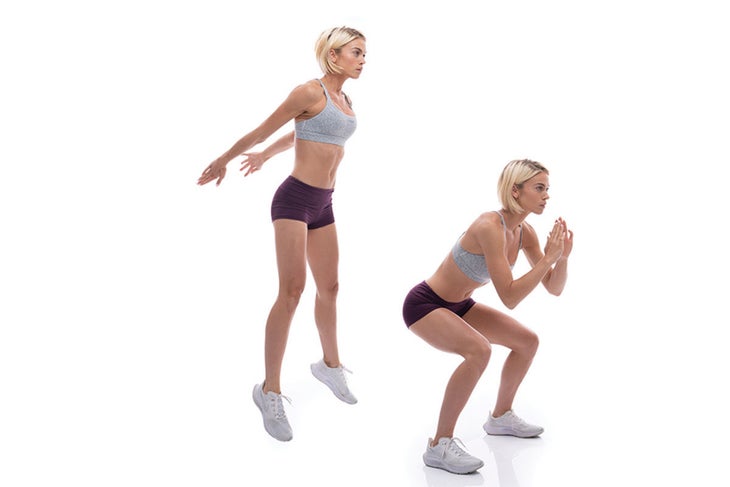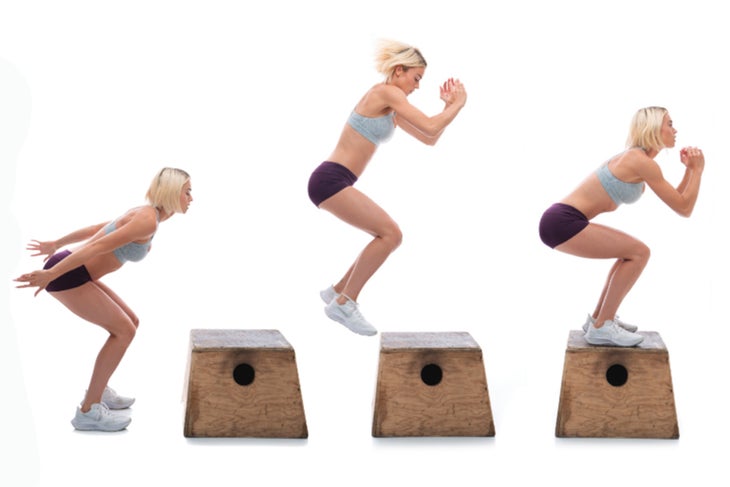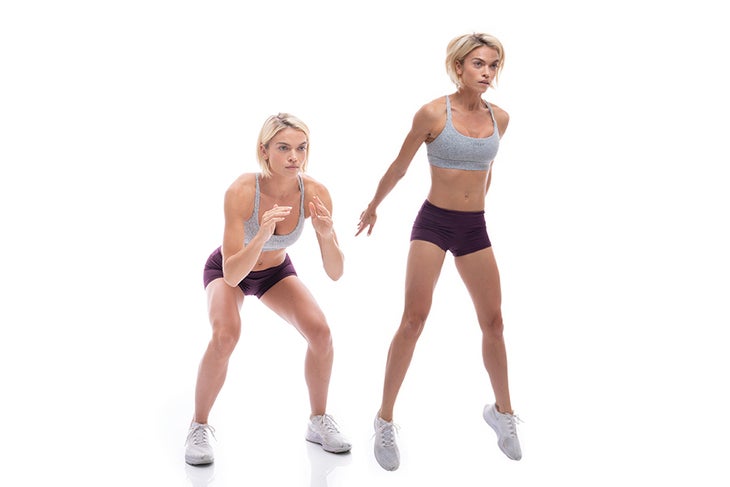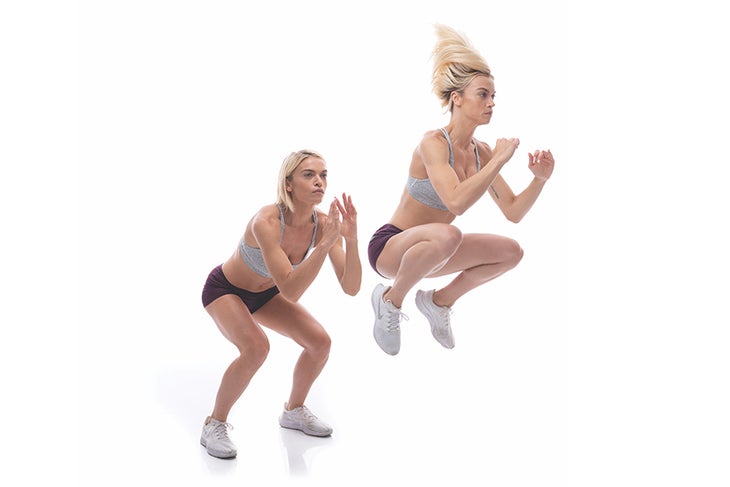Heading out the door? Read this article on the new Outside+ app available now on iOS devices for members! Download the app.
Very little compares to the squat jump for developing lower-body power, and whether your goal is to destroy your quads, spike your heart rate or increase your vertical hops, this move is the gold standard. Use these four moves to level up and reach new heights.

Level 1: Squat Jump to Stabilization
What goes up also must land, and this Level 1 move trains your neuromuscular system to efficiently absorb the impact as your body falls back to earth at a rate of 9.8m/s2. Here, jump height does not matter — it’s all about the landing.
Stand with your feet about shoulder-width apart, toes forward, arms at your sides. Bend your knees and hips to drop quickly into a shallow squat, then explosively extend your hips, knees and ankles to jump straight up into the air. Land softly and absorb the impact by lowering immediately into a shallow squat. Hold three to five seconds and check your form — knees aligned with your second/third toes, chest lifted, hips back, chin level with the ground. Then stand up, rest 30 seconds and repeat.
Troubleshooting
- If you lose your balance upon landing, make your jump a little lower for better control.
- If your knees cave in during takeoff or landing, you may have weak hip and/or knee stabilizers. Strengthen them with moves such as bridges, clamshells and resistance-loop monster walks to prevent injury down the line.

Level 2: Box Jump
Once you’ve mastered your landing, it’s time to work on height. Using a box actually reduces the impact on your joints because the distance you “fall” back to earth is shorter and there is less time for acceleration to build.
Face a box with your feet shoulder-width apart, arms at your sides. Bend your knees and hips to lower into a shallow squat and swing your arms behind you. Then explosively extend your hips, knees and ankles and swing your arms forward as you leap up and onto the box. Land as softly and noiselessly as possible, and hold the landing three to five seconds. Step down one foot at a time and repeat.
Troubleshooting
- Resist the temptation to use a mega-high box. The point here is not to see how high you can lift your legs in front of you but rather to gain vertical height using a moderate box so you can acclimate to “falling” a shorter distance. Yes, there should still be impact but substantially less, meaning your joints can handle more reps.
- Your jump should be vertical for height, not forward for distance. Stand about 6 inches away from the box, or as close as you can without catching your toes on its edge, to ensure you’re on the up and up.

Level 3: Repeat Squat Jump
Linking your reps together trains reactivity — e.g., how fast you are able to redirect the energy from one rep to the next — and the force of your landing acts as a propellant to help launch you back into the air.
Stand with your feet about shoulder-width apart, toes forward, arms at your sides. Bend your knees and hips to drop quickly into a shallow squat, then explosively extend your hips, knees and ankles to jump into the air. Land softly, absorbing your impact by compressing into a squat, then immediately explode into the next rep.
Troubleshooting
- Don’t sacrifice height for speed. Being explosive requires full extension of your hips, knees and ankles, so make sure each rep is perfect.
- Flexion or extension (rounding/arching) of your spine is unwanted movement that wastes energy and could cause back issues, so consciously maintain good posture and brace your core throughout to stabilize your spine.

Level 4: Squat Tuck Jump
This is the big kahuna of squat jumps and is amazing for increasing reactive power. String together a set of 10 to 20 to set your legs and lungs on fire.
Perform a squat jump as with Level 3. Once airborne, quickly lift your knees to hip height in front of you, then extend them quickly and in time to land softly. Rebound right into the next rep.
Each time you return to earth, you’re landing with up to 11 times your bodyweight on impact.
Troubleshooting
- Rounding your back to “hug” your knees tips your center of gravity forward and can cause you to land on your toes. Keep your chest lifted and your focus forward throughout. Better yet, give yourself a tuck target by holding your arms straight out in front of you and aim to touch them with your knees.
- Because the tuck has to be done quickly, you might tend to slam your feet back to the floor. To protect your joints, ensure your landings are always quiet, and jump on softer surfaces such as rubber flooring or grassy areas rather than concrete.